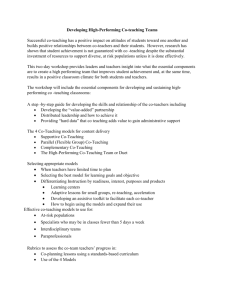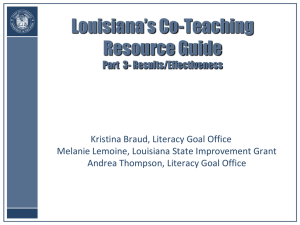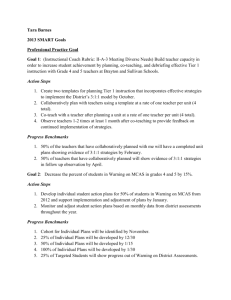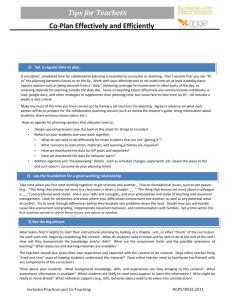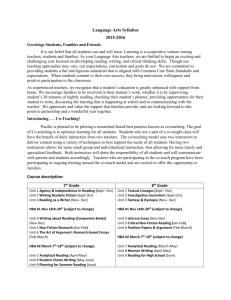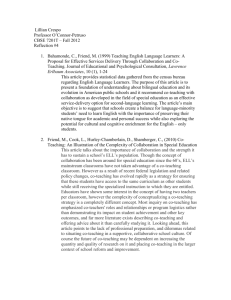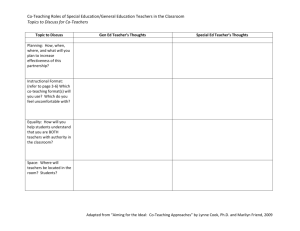Co-teaching1 - Inclusion-strategies101 - home
advertisement
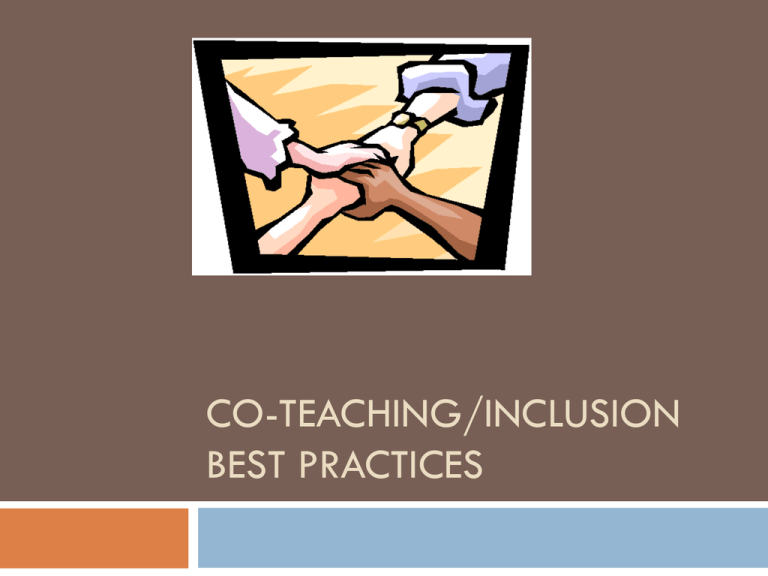
CO-TEACHING/INCLUSION BEST PRACTICES Current Knowledge level of Co-Teaching/Modified Inclusion 1. 2. 3. 4. 5. 6. 7. Whose students are they? Who gives the grade? How do we grade? Whose classroom management rules are used? What do we tell the students? What do we tell the parents? When is there time to co-plan? Purpose Bring an awareness level of current application of Inclusion and where we need to go Outside observer should come in and not know what role each teacher has Help teachers who may not have a opportunity to co-teach and be aware of practices that will assist their classrooms. Rationale: Why Co-Teaching Benefits Students: Develops respect for differences Creates a sense of belonging Improved self-esteem Increased attention Provides peer-models Enables development of friendships Benefits Teachers: Enhances instructional knowledge base Collaborative problem solving skills Shared responsibility More grouping options Teamwork Increased creativity Awareness for individualized instruction Rationale: Why Co-Teaching Promotes a rigorous curriculum to all students Appreciation for diversity Positive academic and social benefits Promotes civil rights for all students Builds supportiveness within school building Increases frequency to make AYP Bedford Area and Everett School Districts Jigsaw • • • You will be given a portion of a chapter from Marilyn Friend’s book “Co-Teach!: A Handbook for Creating and Sustaining Effective Classroom Partnerships in Inclusive Schools” Your group will be assigned a co-teaching approach to read about. You may highlight, take notes, etc. Your group will “teach” the rest of us a co-teaching approach. CO-TEACHING MODELS Best practices for the five most effective Team Teaching Both teachers share instruction One leads, one demonstrates Blends two teaching styles from both teachers Parallel Teaching Model Class is divided in half Teachers plan jointly and teach same subject matter to heterogeneous groupings at the same time Lower student to teacher ratio Increased interaction between student and teacher Station Teaching Material is divided into segments around the classroom Both teachers share responsibility in presenting a lesson Students can work independently at a third station Grouped according to skill level Alternative Teaching One teacher works with larger group, one teacher works with smaller group Smaller group provides enrichment or support Teacher roles are shared All students benefit from small group instruction Wiki-Page https://inclusion-strategies101.wikispaces.com/ A resource for teachers to acquire information to successful implementation Site used to collect feedback on inclusion practices Collaborative environment for regular and special educators to respond confidentially Ticket out the Door: 3 Things You learned about Co-Teaching 1. 2. 3. 2 Questions you still have about Co-Teaching 1. 2. 1 Model you would be open to trying in your classroom 1. Sources "C0-Teaching." http://wik.ed.uiuc.edu/index.php/Co-Teaching. 30/12/2010. CTER, Web. 10 Feb 2010. <index2.php?reqstyleid=0&start=#>. "Benefits of CoTeaching."http://www.lucysmassanow.com/co%20teaching/BENEFITSOFCOteaching.pdf. 30/12/2004. Smassanow, Web. 10 Feb 2010. <index2.php?reqstyleid=0&start=#>. "Team Teaching PowerPoint."https://www.dvusd.org/docs/StuSupportSvcs/Shared_Teaching.pdf. Web. 10 Feb 2010. <index2.php?reqstyleid=0&start=#>. "Co-Teaching in the classroom."http://www.magonline.org/CoTeachingInTheClassroomREVMAGPresentation.pd f. Prince Georges County Public Schools, Maryland, Web. 10 Feb 2010. <index2.php?reqstyleid=0&start=#>. Friend, Marilyn. Co-Teach: A Handbook for Creating and Sustaining Classroom Partnerships in Inclusive Schools. 1st. 211. Print.



